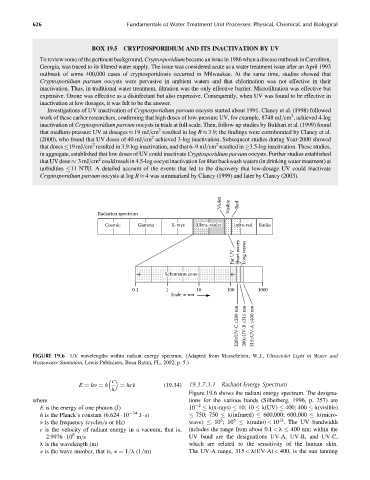Page 671 - Fundamentals of Water Treatment Unit Processes : Physical, Chemical, and Biological
P. 671
626 Fundamentals of Water Treatment Unit Processes: Physical, Chemical, and Biological
BOX 19.5 CRYPTOSPORIDIUM AND ITS INACTIVATION BY UV
To review some of the pertinent background, Cryptosporidium became an issue in 1986 when a disease outbreak in Carrollton,
Georgia, was traced to its filtered water supply. The issue was considered acute as a water treatment issue after an April 1993
outbreak of some 400,000 cases of cryptosporidiosis occurred in Milwaukee. At the same time, studies showed that
Cryptosporidium parvum oocysts were pervasive in ambient waters and that chlorination was not effective in their
inactivation. Thus, in traditional water treatment, filtration was the only effective barrier. Microfiltration was effective but
expensive. Ozone was effective as a disinfectant but also expensive. Consequently, when UV was found to be effective in
inactivation at low dosages, it was felt to be the answer.
Investigations of UV inactivation of Cryptosporidium parvum oocysts started about 1991. Clancy et al. (1998) followed
2
work of these earlier researchers, confirming that high doses of low-pressure UV, for example, 8748 mJ=cm , achieved 4-log
inactivation of Cryptosporidium parvum oocysts in trials at full-scale. Then, follow-up studies by Bukhari et al. (1999) found
2
that medium-pressure UV at dosages 19 mJ=cm resulted in log R 3.9; the findings were corroborated by Clancy et al.
2
(2000), who found that UV doses of 40 mJ=cm achieved 3-log inactivation. Subsequent studies during Year-2000 showed
2
2
that doses 19 mJ=cm resulted in 3.9-log inactivation, and that 6–9mJ=cm resulted in 3.5-log inactivation. These studies,
in aggregate, established that low doses of UV could inactivate Cryptosporidium parvum oocysts. Further studies established
2
that UV dose 3mJ=cm could result in 4.5-log oocyst inactivation for filter backwash waters (in drinking water treatment) at
turbidities 11 NTU. A detailed account of the events that led to the discovery that low-dosage UV could inactivate
Cryptosporidium parvum oocysts at log R 4 was summarized by Clancy (1999) and later by Clancy (2003).
Violet Visible Red
Radiation spectrum
Cosmic Gamma X-rays Ultra–violet Infra-red Radio
Far UV Short waves Long waves
Schumann zone
0.1 1 10 100 1000
Scale in nm
220≤UV-C ≤280 nm 280≤UV-B ≤315 nm 315≤UV-A ≤400 nm
FIGURE 19.6 UV wavelengths within radiant energy spectrum. (Adapted from Masschelein, W.J., Ultraviolet Light in Water and
Wastewater Sanitation, Lewis Publishers, Boca Raton, FL, 2002, p. 5.)
c
n
E ¼ hn ¼ h ¼ hc (19:34) 19.3.7.3.1 Radiant Energy Spectrum
l
Figure 19.6 shows the radiant energy spectrum. The designa-
where tions for the various bands (Silberberg, 1996, p. 257) are
E is the energy of one photon (J) 10 2 l(x-rays) 10; 10 l(UV) 400; 400 l(visible)
h is the Planck’s constant (6.624 10 34 J s) 750; 750 l(infrared) 600,000; 600,000 l(micro-
8 8 12
n is the frequency (cycles=s or Hz) wave) 10 ;10 l(radio) < 10 . The UV bandwidth
c is the velocity of radiant energy in a vacuum, that is, includes the range from about 0.1 < l 400 nm; within the
8
2.9976 10 m=s UV band are the designations UV-A, UV-B, and UV-C,
l is the wavelength (m) which are related to the sensitivity of the human skin.
n is the wave number, that is, ¼ 1=l (1=m) The UV-A range, 315 < l(UV-A) < 400, is the sun tanning
n

